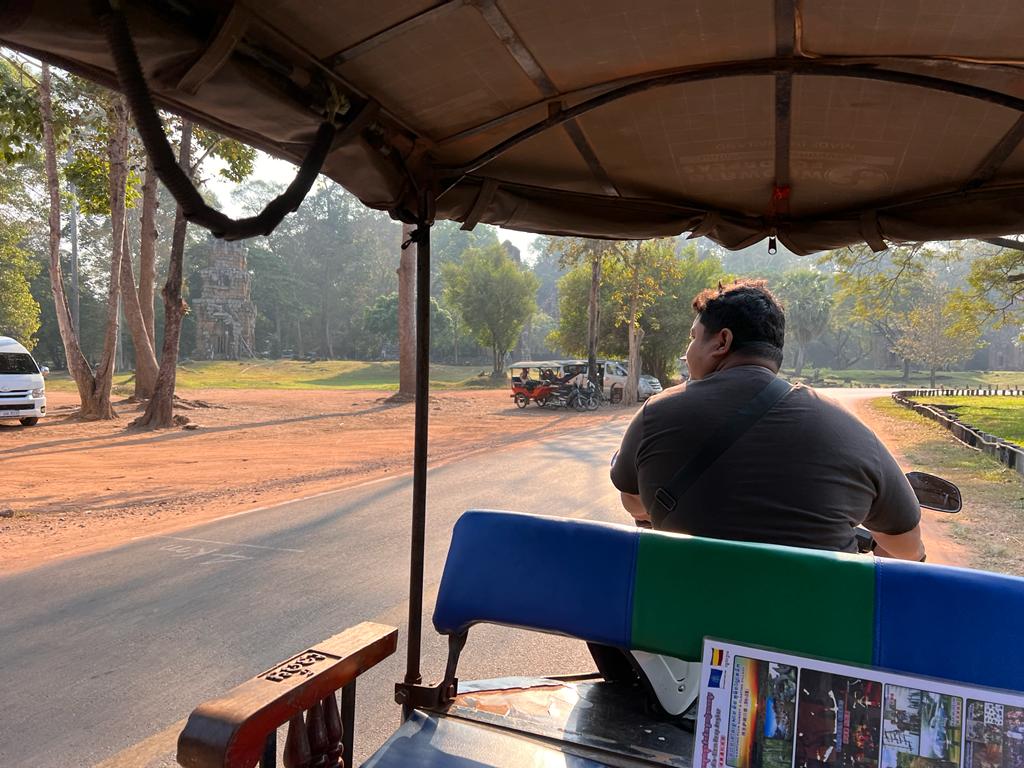Reporting from Angkor, Cambodia, is Raffaele Crocco.

Jorani speaks rarely. In spite of his silence, the name means ‘radiant jewel’. He drives his tuk-tuk and is silent, almost all the time. He drives through the ruins of Angkor and merely recounts the essentials about the ancient power of an empire, the Khmer kingdom, that dominated South East Asia in the 16th century. Suddenly, looking down the street crowded with tourists, something slipped out. He comments: ‘whole families have been driven out of here. We are talking about 10,000 people. The government says it is to preserve Angkor as a Unesco World Heritage site’.
One can tell he doesn’t believe it. Angkor is a heritage site that makes a capital, he says. Two million tourists come to the world’s largest archaeological park every year. The archaeological area is 400 square kilometres of breathtaking beauty.
Jorani looks at us and regrets having spoken. Opposing the government in Cambodia means asking for trouble, and the ears of power are many and unsuspecting. ‘They still promised everyone,’ he adds, concerned, ‘land and money to start life again elsewhere. This is a half-truth. The forced eviction, many say, will benefit foreign investment in the area, especially China, which has made a habit of creating its own amusement parks in this ‘backyard’.
Actually, the news of the eviction is a few months old. In 2022, the government told families to leave their homes and find other places to live. All by the end of 2023. The reason would be due to the need to ‘avoid the destruction of the temples and their removal from the Unesco World Heritage list’. The head of the government, ever-present Hun Sen, in the first weeks promised plots of land, building materials and a small sum to build their homes elsewhere. Then, smelling the anger of the evictees, he switched to threats: those who do not leave by December 2023 will be evicted by force.
 This is creating tensions in a country formally governed by a constitutional monarchy, in fact ruled by an oligarchy that has not let go since the end of the war with Vietnam and the Paris Agreements of 1973. On the road back to Siem Reap, Jorani slows down and pulls over, right in front of a huge construction site. There are dozens of them, just as there are identical ones on the outskirts of the capital, Phnom Penh. Immense construction sites, building residential centres seemingly without logic, mammoth, designed to accommodate – complete with shopping centre – thousands of people. You look around and wonder who is really going to live there. The purchase prices are out of the market, for a country that has a per capita income of $1,625 a year. Across the street, there are shacks. Jorani looks at them. ‘They only build on this side,’ he says. “But who?”, I ask. ‘The Chinese,’ and he starts the tuk tuk again.
This is creating tensions in a country formally governed by a constitutional monarchy, in fact ruled by an oligarchy that has not let go since the end of the war with Vietnam and the Paris Agreements of 1973. On the road back to Siem Reap, Jorani slows down and pulls over, right in front of a huge construction site. There are dozens of them, just as there are identical ones on the outskirts of the capital, Phnom Penh. Immense construction sites, building residential centres seemingly without logic, mammoth, designed to accommodate – complete with shopping centre – thousands of people. You look around and wonder who is really going to live there. The purchase prices are out of the market, for a country that has a per capita income of $1,625 a year. Across the street, there are shacks. Jorani looks at them. ‘They only build on this side,’ he says. “But who?”, I ask. ‘The Chinese,’ and he starts the tuk tuk again.
Beijing is investing mainly in construction, in Cambodia. In 2021, it put $2.32bn on the table, 66 per cent more than the year before. It is the biggest investor in the country and not just for Angkor or construction. It is investing in industry and selling arms to the Cambodian army. Beijing’s strategic objective always remains the same: to have the certainty of trade routes.
Sihanoukville is the leader of these investments, the terminal -privileged. It is the port overlooking the Gulf of Siam. The Americans used it as a point for arms supplies during the Vietnam war years. Now the city is finding new life thanks to Chinese investment. The flow of money is enormous. Beijing is investing in tourist infrastructure for the Chinese, especially in casinos. Then, it is pouring a mountain of money into the port, making it more modern. The strategic importance of the city and the port have always been known. For years, it was the Turkish and Russian mafia that had been vying for control. Today, Chinese and Japanese entrepreneurs are competing for it to the tune of dollars.
For Beijing, control of Sihanoukville brings solutions not only to only economic issues or the commercial struggle with Japan. There is the far more important need to score a strategic advantage over Vietnam, the only hostile country in the area. The Cambodian port is in direct competition with the Mekong Delta, now entirely in Vietnamese territory. The paradox of all this is that helping Beijing in the enterprise is the former Prime Minister Hun Sen, who owes everything to Hanoi. Having fled to Vietnam at the time of Pol Pot’s purges, the bloodthirsty Cambodian dictator of the 1970s, he became Hanoi’s man at the time of the Vietnamese occupation. Then, he was appointed head of government at the end of the war, holding the helm of the country through the troubled 1990s.
Since then he has ruled, with the blessing of 70-year-old King Norodom Sihamoni, imprisoning dissidents and silencing the hostile press. In silence, however, tensions are rising. The Chinese invasion is disliked, especially if, as in Sihanokville, it becomes a foreign but constant presence, locked in a different world. For some – a few – China brings money and progress. For others – the majority – Beijing is increasing misery and social differences. Jorani does not speak of China, nor of the prime minister. He drives the tuk tuk. He heads back towards Siem Reap. ‘This is a quiet country anyway,’ he says, looking at us from the rear-view mirror. ‘I hope you enjoyed yourselves. I’m going home now, to my three children’.
All photographs are the author’s own work. Cambodia, 2023.
























